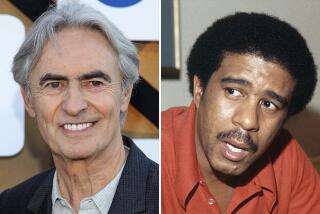Can’t get on the network? Get on the Net
New York — CENK UYGUR was pretty sure he had the makings of a good TV show.
Every afternoon, he and fellow liberal talk show hosts Ben Mankiewicz and Jill Pike spent three hours dishing about politics and pop culture for their irreverent Sirius Satellite Radio program “The Young Turks.” They already had an avid fan base, including listeners who urged the trio to seek a larger audience.
So last year, the Los Angeles-based commentators shot a television pilot in a rented studio and shopped it to the cable news channels, buoyed by a letter-writing campaign to network executives from some of their followers.
No one bit. So Uygur and his co-hosts took the matter into their own hands. “We thought, ‘If they’re not going to put us on, let’s put ourselves on.’ ”
With the help of some investors, the Young Turks bought four professional digital cameras and rented a studio space along Wilshire Boulevard’s Miracle Mile. In mid-December, they began streaming their three-hour show every weekday on their website, www.theyoungturks.com, billing it as the first live Internet talk show.
In the process, they’ve helped pioneer the rapidly developing field of online programming -- from webcasts to video podcasts and vlogs (the video version of a blog) -- now delivering content that traditionally would have had to survive the television development season and pass the muster of network executives to find an audience.
“Anybody can own a broadcast power now,” says Jeff Jarvis, who writes about media and technology on his blog BuzzMachine. “We’re going to have more and more choices. TV will no longer be one-size-fits-all.”
Until recently, original video programming on the Internet has resembled homemade films more than mainstream television shows, appealing to niche audiences with pieces focused largely on youth culture, tech wizardry or quirky personal stories. On one of the most popular sites, Rocketboom.com, host Amanda Congdon delivers a wry three-minute daily newscast about new gadgets and oddball stories. The site Vlogmap.org lists more than 480 vlogs in the U.S. alone, including the heavily trafficked 64mm.com, which boasts that it’s “The First and Best Skateboarding VideoCast on the Net.”
But this new medium is increasingly being embraced by broader constituencies as well. In the case of “The Young Turks,” the program has attracted a growing number of liberals hungry for a political victory -- and excited about the potential of a technology that offers a low-cost way to rally the troops. For Democrats who have long felt outflanked by the right’s heavy presence on talk radio, the Internet program provides a new model of how to get their message out, unfiltered.
“Often in discussions a few years ago, when people were distraught at how conservative the media had become, the conversation often turned to ‘We have to buy a network as an alternative,’ ” says filmmaker Robert Greenwald, who directed “Wal-Mart: The High Cost of Low Price” and is a frequent guest on the show. “But we’re seeing today you don’t have to do that. There are all these fascinating possibilities out there.”
The numbers are small -- an average of 11,000 people tune in every day to the webcast of “The Young Turks,” with an estimated 100,000 more listening in on the radio or through audio podcasts, according to the show. But the program has already entered the political zeitgeist, drawing the kind of guests usually found on the broadcast networks’ Sunday talk shows.
Rep. Henry Waxman (D-Los Angeles), Rep. Louise M. Slaughter (D-N.Y.) and former Rep. Bob Barr (R-Ga.) have all appeared recently, along with environmentalist Laurie David, Adam Green of MoveOn.org and a host of journalists from the New York Times, Newsweek and the Nation.
Pike, who does all the booking, says she used to have to “twist arms” to persuade politicians to come on the program. Now, congressional candidates from around the country regularly call and ask to be interviewed.
“Sometimes we look at guests on ‘Scarborough’ ” -- MSNBC’s “Scarborough Country” -- “and say, ‘I think we’ve out-guested them today,’ ” says the 38-year-old Mankiewicz.
Rep. Tim Ryan, a 32-year-old Democrat from Ohio, says he’s been explaining the concept of “The Young Turks” webcast to his older colleagues and urging them to get on the show.
“This is going to be the equivalent of the talk radio boom of the early ‘90s,” Ryan says. “For us in the progressive movement, being on the cutting edge of this next medium is going to be a real benefit.”
*
A forerunner
“THE Young Turks” wasn’t conceived as a new communications tool for the left. In 1995, Uygur, then a bored attorney in Washington, D.C., started a program on public access television called “The Young Turk” as a forum for his sharp opinions. The show, which aired for two years, was decidedly low-tech: It consisted of Uygur sitting in a chair next to an ugly plant. Nevertheless, he gained a cult following around the capital. Radio and television hosting gigs soon followed, and he quit practicing law.
Seven years later, he and Mankiewicz -- who had worked together on a show in Miami -- pitched the idea of a left-wing political radio program to the fledgling Sirius Satellite Radio network. “The Young Turks” premiered on Sirius in February 2002, and soon afterward, Uygur invited Pike, whom he met working on a television pilot, to join the show.
In the early days, they taped several programs back to back in Uygur’s West Hollywood home, a “dank, dinky little apartment,” 25-year-old Pike recalls. After about a year, they moved to a small studio on Wilshire Boulevard and the show began broadcasting live.
Last April, “The Young Turks” decided to take the program national. It was picked up by local stations in Wichita, Pittsburgh and Seattle and continued to run on Sirius. But fans of the show, who view it as one of the only outlets for liberal discussion on the dial, urged the hosts to try to get onto television as well.
“There’s just a huge audience out there that’s not being served,” says Wendy Foster Dickson, a stay-athome mother of three in a St. Louis suburb, who started a letter-writing campaign to cable networks on behalf of “The Young Turks” on her website CommonSenseMom.com.
Her efforts generated a few phone calls from curious cable executives, but discussions never got off the ground.
Uygur then suggested the idea of an online show. “I’m not a real tech guy; I still don’t have an iPod,” he says. “But I can see where things are going.”
Together, the Turks raised $500,000 -- enough to buy equipment, rent the studio space and pay the staff for a year. The idea: to create a broadcast-quality program available simultaneously on the radio and online.
“This was not one of those ‘Hey, let me put up a webcam in my room,’ ” Uygur says.
Since December, viewers have been able to watch the show live on the website from 3 to 6 p.m. PST, a feed that is also available simultaneously on Sirius. For $10 a month, members have access to archives and extra segments on the website.
The webcast did not get off to an auspicious start -- the overloaded server crashed on the first day. Since then, the staff has worked out many of the technical kinks, but the program still has the feel of a low-budget radio show. The three co-hosts sit around a dark wood conference table wearing unwieldy headsets, speaking into large microphones that block much of their faces. The rest of the sparse set consists of a bookcase and a television screen with a brightly colored “The Young Turks” logo.
Pike spends most of the show staring at a laptop, a venti Starbucks cup propped up on the table in front of her as she chats online with viewers. She and her co-hosts banter like siblings, riffing on everything from Jessica Simpson’s divorce to the administration’s stance on the war in Iraq. The Democratic establishment comes in for a large share of abuse, as well, as they sarcastically deride the party’s leadership.
“Sometimes we may seem a little rough around the edges, but I don’t think we ever seem canned,” Mankiewicz says. “There is a genuine quality I think that will enable us to break through.”
Of course, what it means to break through in the crowded world of Internet programming remains to be seen. “The challenge is that it is difficult to cut through the din,” Greenwald says.
Uygur says he doesn’t hold out hope that a program like “The Young Turks” could ever go head to head with a broadcast or cable show.
Rather, he says, “I think the Internet is going to be seen as a talent pool. In the past, you had to tour the country’s comedy clubs or watch local news tapes. Now, you can look online to see what has already worked in a really, really tough environment. On the Internet you don’t start with a lead-in of ‘CSI.’ You start with a lead-in of zero -- flat zero.”
Despite that, “The Young Turks” generated substantial buzz in the blogosphere in January when the show streamed live for 99 hours straight as the hosts urged the Democrats to filibuster Samuel A. Alito Jr.’s nomination to the Supreme Court. They were bolstered by other liberal talk show hosts like Air America’s Thom Hartmann and John Amatos of the website Crooks and Liars, who pitched in for stints so they could get some sleep. When a peak of 25,000 viewers tuned in, crashing the server, other websites donated server space to keep the show online.
After that, Uygur says, he began to truly grasp freedom afforded by a technology that comes with no time limits or content restrictions. In February, “The Young Turks” was one of the only U.S media outlets to show viewers new photos of American soldiers mistreating detainees at Abu Ghraib prison in 2003 that had been obtained by Australian television. Next, they’re thinking about offering news updates throughout the day and shooting their own stories outside of the studio.
“This is wide open,” Uygur says. “We can do anything we dream of.”
More to Read
Sign up for Essential California
The most important California stories and recommendations in your inbox every morning.
You may occasionally receive promotional content from the Los Angeles Times.










